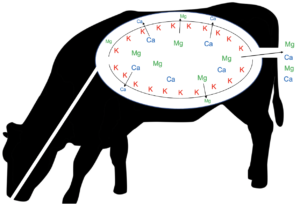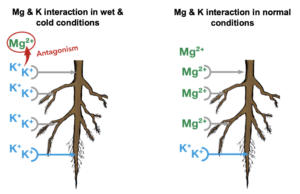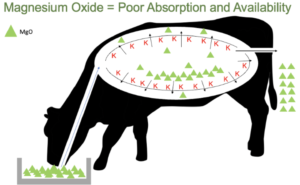Grass tetany (hypomagnesaemia) is one of the leading causes of mortality in adult cows in south-eastern Australia and is estimated to cost $13.7 million in lost production annually.1
Autumn and winter of 2021 and 2022 were two of the most challenging grass tetany seasons on record, with some regions in southern Australia reporting cattle losses in the thousands. Although southern parts of the country are expected to experience a drier winter compared to the two previous years, the AusFarm Nutrition team are reminding producers to be vigilant this year when grazing lush green pasture.
At AusFarm Nutrition, we believe that it is a good exercise to return to the basics, understand the disease and adopt proactive grass tetany risk mitigation measures when managing cattle grazing lush green feed throughout autumn and winter.
Key Points
- Grass tetany is caused by low concentrations of magnesium in the blood
- Potassium (K) has an antagonistic relationship with magnesium (Mg) within the rumen, but also within the pasture
- Short term management involves offering a highly available Mg supplement daily
- StockGro-HiMag liquid feed supplement is extremely effective in reducing the incidence of Mg deficiency related diseases
- Mg supplementation in deficient livestock has been shown to boost production
Causes of grass tetany
Although grass tetany is caused by low concentrations of magnesium in the blood, it is important to understand what causes this to happen. There is a common belief that low levels of magnesium in feed is the cause. This is true to an extent, but it is missing a key part of the story.
Low blood magnesium, in most cases, is caused by the misalignment of magnesium ingested in feed and absorbed in the rumen and the amount of magnesium used in the body and lost through milk.
As magnesium is continually drawn from lactating cows into the calf, it is important to secure adequate magnesium to replace that which is lost. In many cases, growing green winter pasture contains enough magnesium to satisfy lactation.
However, two similar interactions between magnesium and potassium, one within the rumen and the other in the soil, limit the availability of magnesium to the animal.
Interactions within the rumen
Potassium (K) has an antagonistic relationship with magnesium (Mg), where high concentrations of potassium in the diet can interfere with the major sites of magnesium absorption. Through this, high levels of potassium reduce the amount of magnesium being absorbed in the rumen and therefore decrease the amount of magnesium entering the bloodstream for the animal to use (See fig 1).

Interactions in the soil
Studies of interactions between magnesium and potassium within the soil have revealed that high concentrations of potassium have a negative impact on magnesium absorption by the roots.
The same impact can also be seen in balanced potassium soils on wet, cold days where pasture growth significantly slows. In these circumstances, the concentration of potassium builds around the roots of the plant replacing magnesium (see fig 2).
As the wet and cold days continue with limited plant growth, the concentration of potassium continues to build. It is the following warmer, sunny day where grass tetany issues are realised. This is because when the plant begins to grow, it absorbs a high concentration of potassium which then impacts magnesium absorption in the rumen.

Interestingly, prolonged cold and wet conditions exacerbate the issue in two ways.
Firstly, animals tend to graze less in rainy conditions, reducing feed intake (dry matter intake).
Secondly, wet pastures increase the amount of water consumed by the animal and held in the rumen, once again lowering the amount of dry matter intake.
On the next sunny day, hungry animals tend to eat more than usual and fill their guts with high potassium pasture.
Prevention and control
Management strategies adopted should aim at preventing grass tetany from occurring rather than treating the disease. Acute forms of the disease are rapid, and death is often the first observed symptom. Successful prevention of grass tetany involves an integrated approach that aims at:
- Allowing animals access to continuous supplies of adequate levels of supplementary magnesium
- Maximising absorption of magnesium in the gastrointestinal tract by delivering available sources of magnesium
- Offering an available magnesium supplement well ahead of the danger period to ensure that magnesium levels don’t reach critically low levels leading into winter
- Identifying agronomic practises that can reduce absorption or interfere with normal magnesium metabolism, e.g., application of potash or urea and feeding dual-purpose forage cereals.
Magnesium supplementation should be delivered daily as the body has limited sources to pool from and has daily obligatory losses associated with maintenance (3mg/kg LW) and lactation (120mg/kg of milk). Supplying a supplement high in available magnesium is the most common and efficient method used to meet daily requirements.
The source of magnesium is important for maximising the availability of magnesium to the animal.

Although MgO (Causmag) has a high concentration of magnesium (59% Mg), it is less soluble and less available to the animal than other highly available sources of magnesium, like magnesium sulphate (10% Mg) which is highly soluble. StockGro-HiMag and StockMins-BoviMag contain multiple sources of soluble magnesium to maximise absorption and therefore availability to the animal.

StockGro-HiMag and StockMins-BoviMag
For cattle facing mild challenges, a free access, flavoured, weather resistant, granular supplement such as StockMins-BoviMag is suitable. However, where farm history and prevailing conditions suggest a high magnesium challenge, StockGro-HiMag liquid feed supplement has repeatedly shown to be highly effective in cattle. These supplements do not only deliver a continuous supply of available magnesium in the form of soluble salts, to increase absorption across the whole gastro-intestinal tract, but are also fortified with acid salts to encourage magnesium mobilisation and availability, a complete blend of trace elements and the option for the addition of Bovatec®.
It should be noted that sodium is also key to magnesium absorption and many fast-growing cereal crops are very low in sodium. Salt is an integral part of all of ANP’s mineral supplements.
ANP’s HiMag range not only reduces the risk of grass tetany but boost’s feed efficiency, live weight gain and milk production.
| StockGro – HiMag | A molasses-based liquid feed supplement containing 5% of highly available magnesium to enhance metabolism and prevent the onset of magnesium deficiencies such as grass tetany. |
| StockMins – BoviMag | A granular based loose-lick feed supplement containing 7.1% of available magnesium to enhance metabolism, boost growth and prevent the onset of magnesium deficiencies such as grass tetany. |
Contact us for more information on combatting grass tetany
References
1. Priority list of endemic diseases for the red meat industry – 2022 update. MLA, 2022